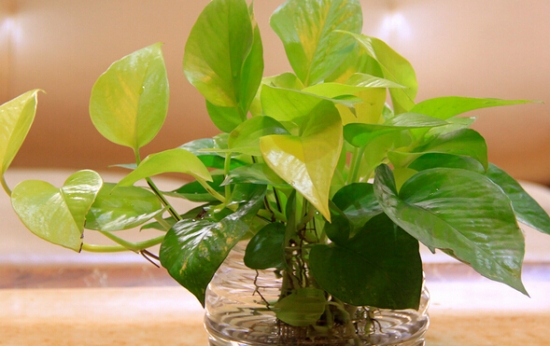What about plant rot?
What about the rotten roots of plants? There are many reasons for the rotting roots of flower plants, mainly as follows:
The main results are as follows: (1) the sticky weight of the basin soil: the soil is easy to harden and the surface of the basin soil is dry and white, but the interior of the basin soil is not dry and seems to be short of water on the surface, but watering can easily cause the soil to be too wet and lead to poor root growth and even rotting roots.
(2) too much watering: too much watering can easily cause root hypoxia, water occupies most of the soil space, resulting in a reduction of oxygen content around the root system, making it difficult for plants to breathe, and finally lead to root rot, plant wilting and death.
(3) the water temperature and soil temperature are inconsistent: when the watering water temperature is much lower than the soil temperature, it will cause root physiological imbalance and lead to the death of rotten roots.
(4) improper fertilization: excessive concentration of fertilizer or the application of immature fertilizer will cause rotting roots of the plant, the former is due to the "burning" of thick fertilizer, and the latter is due to the heat "burning" caused by the fermentation of immature fertilizer in the soil.
(5) improper root pruning: flowers with fleshy roots often have to split their roots when they split plants; some flowers also have to cut off the roots that are too long, too old and too dense when changing pots. After replanting, there will also be the phenomenon of root rotting due to the inability to heal infected germs. the above is an introduction to how to do rotten roots of plants.
What about the rotten roots of plants?
As the saying goes, "if you often walk by the river, there are no wet shoes." it is also common to grow flowers and encounter rotten roots of plants, so how to deal with rotten roots of plants and how to prevent them is the main thing. This article will discuss some things about rotting roots of plants with flower friends for reference!
To say in front: we should first divide the rotten roots of plants into plants, such as succulent plants, orchids, woody plants, herbaceous plants, these categories will also involve individual varieties, not all plant rotting roots are treated in the same way. Flower friends should learn and use them, not blindly.
The rotting roots of plants are mostly caused by long-term stagnant water and stuffy soil. Flower friends must keep in mind that less water can be given when protecting plants. Plants are not easy to die of drought, but if there is stagnant water, they are very easy to die of waterlogging. It is often said that it is better to dry than wet.
Here are the common treatment methods for rotting roots of plants:
1. Clean up the rotten parts, then disinfect them, dry them, and replant them. This method is mainly aimed at plants with unfinished roots, such as orchids and orchids.
2, the use of branches re-cutting, now the more popular succulent plants, in the root rot, can use branches, or leaves to reproduce.
3. For plants that are difficult to save, many flower friends also raise some woody potted plants in their homes, such as rich trees. Once these plants have rotten roots, the possibility of saving them is less than 10%. In most cases, they will die slowly, because by the time the rotten roots are found, it is too late.
Finally, what to do with the rotten roots of plants is a very flexible question. Flower friends must formulate different rescue methods according to different plants. Some plants have the characteristics of easy reproduction, and we can use this to save them, such as leaf cuttings, cuttings, etc., while some plants are easy to take root, and as long as there is a little root tissue, they can take root and recover, and we will use the method of cleaning up the rotten parts and replanting to save them.
Next, leave an exercise for flower friends. How to deal with the rotten roots in the Douban green in the picture below?

The right way to deal with it is to cut off the rotten parts and keep the healthy branches back to cuttage. I wonder if that's what you think.
What about the rotten roots of hydroponic plants? Methods to avoid rotting roots of hydroponic plants
Hydroponic flowers are cleaner than soil potted plants and do not need watering, so many flower lovers like hydroponic flowers. For example, hydroponic turtle back bamboo, green pineapple, Guangdong evergreen, rich bamboo, hanging orchid and bulb flower tulips, lilies, hyacinth and so on. But in the process of hydroponic culture, many flower lovers will encounter the problem of rotten roots, so how to avoid hydroponic rotting?
First, how can we avoid rotting roots?
First of all, we should change the water regularly according to the types of flowers and the adaptation to hydroponics.
Especially like water flowers, or aquatic flowers, very adapted to the growth environment of hydroponic culture, hydroponic culture can quickly take root, and grow well, this kind of flowers can change water for a longer interval.
And some flowers can not adapt to the hydroponic environment, hydroponic growth is slow, or even rotten roots, this kind of flowers need to change water frequently.
In the initial stage of hydroponic culture, we should often sterilize, change water, or even change water every 1-2 days. After taking root, we will restore growth and gradually reduce the number of times of changing water.
Second, how to make flowers quickly adapt to the hydroponic environment?
1. Wash the roots
Root washing method of hydroponic culture refers to the soil culture of the finished flowers, the root of the soil is cleaned, and then hydroponics, cleaning should try to use flowing water.
After cleaning the root of the flower, put it into a prepared vessel, fix it, and inject less than half or more than half of the root with clean water.
At the beginning, you should keep changing the water once a day, wash the roots and utensils at the same time, and reduce the number of water changes after a week.
If the hydroponic flowers grow new roots in the water, or grow obviously, it means that they have adapted to the hydroponic environment, and the water can be changed every 7-10 days.
2. Water plug
Water insertion is the simplest and easiest method of hydroponic culture.
On the selected flower mother plant, cut off a section of the branch, cut off the branch, the cross section should be kept flat, there should be no longitudinal cracks, and then insert the branch into the water and change the water every 2-3 days until the new root grows.
The above is Huinong net Xiaobian collation of how to better cultivate hydroponic plants, so that hydroponic plants do not rot roots. Finally, no matter which method of hydroponics, in the process of hydroponics, often change water, wash roots, sterilization and disinfection, for hydroponic flowers, it is particularly important to prevent rotting roots!
- Prev

What is the reason for the yellowing of flower leaves
What is the reason why the leaves of flowers turn yellow? The phenomenon of yellowing of leaves often occurs in the growth process of potted flowers, and there are many reasons for yellowing of leaves, and sometimes it is the result of the joint action of a variety of reasons. therefore, in the process of maintenance, it is necessary to carefully observe the causes of yellowing of flower leaves in order to prevent and cure them.
- Next

Propagation methods of Milan Flower
Milan uses high pressure and cutting methods to propagate Milan flowers. High-pressure propagation should select 1-year-old 2-year-old strong branches from May to August, and then wrap them with moss, wet soil and vermiculite when the incision is slightly dry, fasten the plastic film up and down, and cut off the basin or transplant after rooting for 50 to 100 days.
Related
- Fuxing push coffee new agricultural production and marketing class: lack of small-scale processing plants
- Jujube rice field leisure farm deep ploughing Yilan for five years to create a space for organic food and play
- Nongyu Farm-A trial of organic papaya for brave women with advanced technology
- Four points for attention in the prevention and control of diseases and insect pests of edible fungi
- How to add nutrient solution to Edible Fungi
- Is there any good way to control edible fungus mites?
- Open Inoculation Technology of Edible Fungi
- Is there any clever way to use fertilizer for edible fungus in winter?
- What agents are used to kill the pathogens of edible fungi in the mushroom shed?
- Rapid drying of Edible Fungi

